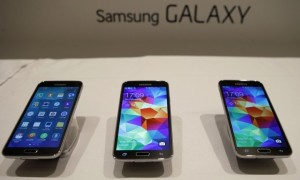 Things are out of whack at Samsung and a number of fairly drastic changes are in store.Start with the company’s crown jewel, the Galaxy S5 smartphone: Samsung sold 40% fewer Galaxy S5 smartphones than expected, leaving the phones piled up in warehouses, according to the Wall Street Journal.
Things are out of whack at Samsung and a number of fairly drastic changes are in store.Start with the company’s crown jewel, the Galaxy S5 smartphone: Samsung sold 40% fewer Galaxy S5 smartphones than expected, leaving the phones piled up in warehouses, according to the Wall Street Journal.Sales of the Galaxy S5 reached 12 million units in the first 90 days since they went on sale in April, compared to sales of 16 million Galaxy S4’s for the same period the year before, the report added. The Galaxy S5 predicament was made worse because Samsung’s mobile division, headed by J.K.Shin, allowed 20% more Galaxy S5’s to be produced than its predecessor.
The report indicated that Shin could lose his role as mobile head and co-chief executive, although Samsung wouldn’t comment on Monday.
The insights on the failings of the Galaxy S5 haven’t surprised analysts and reviewers who didn’t like the smartphone with its plastic case, especially in a market that is shipping more top Android competitors from Motorola and LG Electronics. The smartphone market is also expanding with mid-priced and low-priced Android phones from makers including Xiaomi, Lenovo and Huawei in huge markets such as China. The release of the iPhone 6 and iPhone 6 Plus in September didn’t help.
Another big concern: Samsung’s net profit fell 49% in the third quarter following the poor sales of the Galaxy S5. Samsung had operating profit margins above 15% for 10 consecutive quarters before the third-quarter margin fell to 7%, the lowest since 2008.
Why it matters: IDC reported Samsung’s market share dropped to 23.8% in the third quarter, down from 32.5% a year earlier.
Samsung has already announced some adjustments, saying recently it would cut the number of smartphone models it will make by 25% to 30% next year. Samsung also declared it will focus on improving product competitiveness for each smartphone price tier, including those phones with flexible displays and metal frames.
That metal frame commitment seemed to be a direct response to deep criticism of the plastic Galaxy S5 case.
“The Galaxy S5 has been an unmitigated disaster for Samsung,” said Patrick Moorhead, an analyst at Moor Insights & Strategy. “They chose some wrong features to invest in, like heart rate monitoring – who wants to measure their heart rate like that? The phone is plastic, too, and feels cheap to the touch. Premium phone owners want more from their phones.”
The Exynos processor in some of the international Galaxy S5 models was slow compared to other phones with processors from Apple, Nvidia and Qualcomm. “The phone was brutalised in the benchmarks,” Moorhead said.
Since the U.S. market is important to phone makers, including Samsung in the higher-priced segment, Samsung can be hurt by the LG G3 and other comparable models that could cost less than the Galaxy S5. (For example, Verizon Wireless now has the Galaxy S5 on a two-year contract for $200, down from $250, while the LG G3 is now $150, down from $200. )
Even so, the U.S. is just one market and Samsung’s biggest volume losses are in countries like China and emerging market southeast Asian markets.
If Shin is moved aside as mobile chief at Samsung, he could be replaced by Boo-keun Yoon, another co-CEO who oversees Samsung’s consumer electronics business and would reportedly take on the mobile role as well. That move would give Samsung a strategic direction toward combining mobile devices with home electronics products that are Internet-connected.
What Samsung needs to do
A management shift at Samsung won’t automatically fix matters.
Samsung needs a big overhaul “to focus on the technologies and experiences that premium phone consumers want,” Moorhead said. “They have to stop living in the past when they did have an advantage on Apple. Even their ads are living in the past.
“Samsung needs to dig deep and invent that next technology and experiences that are valuable to consumers and that Apple doesn’t have,” he added.
Jack Gold, an Analyst at J. Gold Associates, said an even bolder brand-focusing adjustment should be in order for top Samsung managers. “Samsung’s challenges are not so much about management as they are about what the brand stands for,” Gold said. “In the past, Samsung was the brand to go with if you wanted Android instead of iPhone or BlackBerry. Now, with so many other vendors making credible, quality Android devices, Samsung becomes just another commodity maker of devices. So getting the brand back may be partially solved by shuffling the deck of executives, if they can get some execs with strategic vision to right the process.
“But largely Samsung has to reinforce its brand as the leader in Android, against the iPhone juggernaut and that may be hard to do. Samsung needs to be the ‘halo’ brand, not the commodity brand.”





